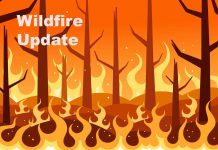EDMONTON – Wildfire Update – Jasper evacuees can now apply for emergency evacuation payments. Alberta Wildfire crews continue to assist Parks Canada with the wildfires burning in the Jasper townsite and Jasper National Park.
Alberta is experiencing another destructive wildfire season, with the communities of Fox Lake, Chipewyan Lake, Garden River, John D’Or Prairie and the municipal district of Bighorn have been ordered to evacuate.
As Albertans are left reeling from the reports of homes, historical structures and businesses having been lost to the fast-moving wildfires in the Jasper National Park, the full weight of the Alberta RCMP’s support during these exceptionally traumatic times.
RCMP-aided Evacuation of Jasper
RCMP members, with the invaluable support of Alberta Sheriffs and Parks Canada Wardens, safely directed traffic out of the Jasper townsite late Monday evening into early Tuesday morning.
On Tuesday morning, 20 members from various branches of Search and Rescue (SAR) Alberta helped RCMP members conduct door-to-door checks of every residence in the Jasper townsite. Working in teams of two, one RCMP member and one SAR volunteer, methodologically moved through the town and documented those who had yet to evacuate.
Initial door knocks occurred between 9 a.m. and 1 p.m., with 41 residence electing to stay in place. Later in the day, after our second check in, only 6 residence remained.
Eventually only one elderly couple remained, who’s health and mobility issues precluded them from leaving town independently. It took two members 30 minutes to help evacuate the couple. Their home was destroyed shortly there after.
Securing Entry into the National Park and the Townsite
Concurrent to the door-to-door checks, Tactical Support Group (TSG) members from Sherwood Park, Parkland, Fort Saskatchewan, Okotoks, Innisfail, Lloydminster, Coaldale, and High Level RCMP detachments converged onto the townsite to help facilitate evacuations and to secure the highways into the national park.
Securing the Jasper Townsite
The Alberta RCMP understand that the protection of your property is second only to the protection of your loved ones. While the 2023 Wildfire Season had no credible reports of looting, with below average instances of break and enters and trespassing, the Alberta RCMP and partners will employ a number of policing strategies to enhance the safety and security of evacuated communities during the wildfires:
Restricted Airspace: All commercial and personal aircraft, and including drones are restricted from flying in the Jasper National Park. This is an important precaution to ensure that airtankers, helicopters, and patrol aircraft can safely respond to the wildfire.
Perimeter Control: By maintaining tight access control into an evacuated community, the Alberta RCMP can easily ascertain who’s authorized to work in a specific area and who might be unlawfully in the community. We’ve established communication protocols and ongoing collaboration with the Jasper Emergency Operations Centre to validate authorized personnel.
Roving Patrols: With the perimeter secured, marked police car patrols will proactively move through your community actively looking for signs of criminal activities, as well as individuals who are not authorized to be in the evacuated area. To enhance patrolling ability throughout the night, advanced optical and night vision technology mounted on our Remotely Piloted Aircraft Systems (drones) are being utilized to identify and accurately pinpoint any suspicious activity in your evacuated community.
Quick Response Teams: Our Tactical Support Group Quick Response Teams are in place to react to any incidents in area. These members are specially trained officers equipped to deal with the most sensitive and dangerous situations.
Investigative Teams: Experienced Division Criminal Analysis Section will analyze and examine reports of suspicious activity and individuals. Our investigators will conduct targeted investigations of priority offenders, criminal hot spots and utilize both overt and covert techniques to actively suppress crime and arrest those looking to take advantage of the evacuation.
Crime Reduction Techniques: Various Crime Reduction equipment and strategies are being implemented within and around the evacuated areas. Specialized Crime Reduction teams utilize covert crime detection and overt crime suppression strategies focusing on offenders who are causing harm to our communities.
First responders from British Columbia and Alberta are working under exceptional circumstances. Please help us to keep everyone safe by listening to the advice from local authorities and staying away from evacuated areas until you have been cleared to return.
Evacuation orders and alerts:
- The Municipal District of Bighorn’s evacuation order for the area east of Highway 40 and west of the Ghost Public Land Access Point remains in effect. An evacuation alert is also in effect for the surrounding area. A reception centre is available at the Water Valley Community Hall.
- An evacuation order for Jasper and Jasper National Park remains in effect. Reception centres in Grande Prairie, Calgary and Edmonton are providing support to evacuees:
- Grande Prairie reception centre: Bonnets Energy Centre, 10017 99 Avenue.
- Calgary reception centre: Shouldice Arena, 1515 Home Road NW.
- Edmonton reception centre: Kennedale Site Building #2, 12814 58 Street.
- Evacuation orders for Little Red River Cree Nation (John D’or Prairie, Fox Lake and Garden River) remain in effect.
- The Municipal District of Opportunity’s evacuation order for Chipewyan Lake is still in place.
- Alberta Emergency Alerts are issued by local authorities and are updated at their discretion. For the best source of information on the status of evacuation orders and alerts, residents are encouraged to follow their local authorities’ preferred communication channels for updates.
- Albertans are encouraged to download the Alberta Emergency Alert mobile app, which immediately pushes all alerts out to subscribers.
- Evacuees can also call the Government of Alberta contact centre at 310-4455 for assistance.
Current situation
- There are 163 wildfires currently burning across Alberta.
- Of these wildfires, 51 are classified as out of control, 47 are being held, 75 are under control.
- Since July 25, there have been no new wildfires in the Forest Protection Area.
- The response is focused on the wildfires that pose a direct threat to human life, communities, critical infrastructure and major industrial facilities.
- The Municipality of Jasper and Jasper National Park remain under an evacuation order due to out-of-control wildfires burning in Jasper National Park.
- Unified command, which includes Parks Canada and the Municipality of Jasper, are releasing information about structural damage as able.
- Alberta’s government is providing personnel, helicopters and air tankers to help fight the wildlife, which is under Parks Canada jurisdiction.
- The Kettle River Complex, which includes wildfire LWF136, is located approximately 12 kilometres north of the community of Janvier and three kilometres from Highway 881.
- It is estimated at 765 hectares in size and is classified as being held.
- Wildfire smoke may be affecting visibility on highway 881. Visit 511 Alberta for details.
- An out-of-control wildfire (CWF507) is burning about 25 kilometres west of Water Valley.
- This wildfire, detected on July 22 and currently 80 hectares in size, was caused by lightning.
- The Semo Complex Fire (HWF061) is classified as out of control at more than 96,000 hectares in size.
- It is approximately 2.2 kilometres from Highway 58, 13 kilometres from Garden River, 19 kilometres from John D’Or Prairie and 15 kilometres from Fox Lake.
- Wildfire SWF120 is classified as out of control. It is located about 20 kilometres northwest of Chipewyan Lake and is more than 12,600 hectares in size.
- Since January 1, there have been 977 wildfires in the Forest Protection Area, burning more than 552,000 hectares.
- Alberta currently has almost 1,900 personnel, 156 helicopters and 21 aircraft responding to wildfires across the province.
- In addition to provincial resources, Alberta has imported firefighters, support staff and equipment from other jurisdictions to support wildfire response and suppression efforts.
- 100 firefighters from Mexico arrived in Edmonton last night. Support from South Africa will arrive in the coming days.
- Although lightning has caused more than half of the wildfires burning today, the other half are caused by people. Albertans are urged to prevent any additional fire starts that will add to the already extreme wildfire situation.
- Air tankers may use water from nearby lakes to fight wildfires. If you are in the water and see an aircraft coming to collect water, please move to the shore. Failing to do so impedes firefighting efforts. Albertans who do not comply could face a mandatory court appearance.
- Information about wildfires can be found by visiting the Alberta Wildfire Status Dashboard.
Fire bans
- A fire ban is in place for the entire Forest Protection Area of Alberta.
- For information on activities prohibited under this ban, visit alberta.ca/fire-bans.
- Cities, towns, villages and summer villages, as well as federal lands, such as national parks, are exempt from this ban.
- These jurisdictions have the authority to issue their own bans and may have complementary bans in place.
- Albertans should visit their local municipality’s website or social media to confirm if a fire ban is in effect in their area.
- All Albertans have a role to play in wildfire prevention. Albertans must follow all fire bans and restrictions to avoid new fire starts. If you see smoke or flames in the forest, call 310-FIRE to report it.
- Applying FireSmart principles to homes and property can mitigate the risk of wildfire damage. Removing flammable materials and vegetation around the property and preventing embers from accumulating can help protect your home from wildfires. To learn more, visit FireSmart Alberta.
Air quality
- Wildfire smoke is affecting air quality in parts of Alberta. The combination of heat and very poor air quality will increase the risk to your health, especially when taking part in strenuous activity. Visit Wildfire Smoke Information for air quality monitoring information to make informed decisions about outdoor activities to protect your health.
- Wildfire smoke can cause a variety of symptoms or health effects that can range in severity. Milder and more common symptoms of smoke exposure include:
- headaches
- a mild cough
- production of mucus
- nose, throat, eye and sinus irritation
- In many cases, these symptoms can be managed without medical intervention.
- Air quality monitoring is managed by Alberta Environment and Protected Areas (EPA) and local airsheds using continuous air monitoring stations in more than 40 communities across Alberta.
- Real-time data from these continuous stations inform Albertans about current air quality conditions through the Air Quality Health Index (AQHI).
- Environment and Climate Change Canada (ECCC) collaborates with EPA, Alberta Health and Alberta Health Services to issue alerts to inform the public of real-time air quality conditions, as well as health messaging to suggest proactive measures to protect their health.
- Special Air Quality Statements are issued when the AQHI reaches seven, and will show up as grey on the ECCC public weather alerts map,
- An Air Quality Advisory will be issued when the AQHI reaches 10+ due to wildfire smoke and shows up as red on the public weather alerts map, with a red banner on the city’s weather page and WeatherCAN app to alert the public of more severe health effects than when a special air quality statement is issued.
Getting involved in wildfire response
- We’ve heard from Albertans who are eager to support wildfire operations near their communities, and we’re providing opportunities to do so through the Wildfire Reservist Program.
- If you’re interested in lending a hand, learn more at alberta.ca
Eligible for Emergency Evacuation Payments
- Following reports of widespread damage and the ongoing fire situation at the Jasper townsite and National Park, residents who left their homes as part of the mandatory evacuation order are now eligible to receive emergency evacuation payments.
- Temporary foreign workers and seasonal workers who were employed and residing in Jasper National Park or Town of Jasper are also eligible for this one-time payment.
- Jasper evacuees are being routed to Edmonton, Calgary and Grande Prairie. Staff at Alberta Supports Centres are available to assist evacuees if needed.
- Residents from Janvier 194 (part of Chipewyan Prairie First Nation), MD of Opportunity No. 17/Chipewyan Lake and Little Red River Cree Nation, Garden River impacted by mandatory evacuation orders are eligible for emergency evacuation payments.
- Individuals who are part of a mandatory evacuation order exceeding seven days may be eligible to receive a one-time payment of $1,250 for each adult and an additional $500 for each child under the age of 18.
- Evacuees are encouraged to apply for these emergency payments online at evacuationpayment.alberta.ca or contact the Alberta Supports Contact Centre at 1-877-644-9992 for assistance.
- All Albertans who have evacuated their communities due to wildfires can access Alberta Supports offices for in-person assistance. Alberta Supports office locations and updated hours are available at alberta.ca/alberta-supports.
- Those in need of immediate emergency financial assistance as they leave their community can contact the Income Support Emergency Contact Centre at 1-866-644-5135. The Contact Centre operates 24/7.
- People who left their home community, but who were not part of a mandatory evacuation order, are not eligible for payment.
Roads and highways
- Alberta’s highway’s that are impacted by the wildfires will open and close frequently as the safety situation varies in the weather conditions. Please be patient and respect the staff at the closure/detour sites – they are there with your safety in mind.
- 511 Alberta remains the best source of information as conditions change on our highways. Visit 511.alberta.ca.
Jasper Area – Highway 16 and Highway 93 closures:
- Highway 93 northbound is closed to all traffic at the Saskatchewan Crossing (Highway 11) to Jasper townsite (Highway 16).
- Highway 16 from the B.C. border is closed to incoming traffic in Jasper National Park due to wildfire operations. No estimated time of reopening is available at this time. Traffic is permitted to leave Jasper westbound.
- There are two checkpoints:
- Highway 16 / Highway 40 west of Hinton (motorists are permitted to leave eastbound but are prevented from entering westbound)
- At the B.C. border checkpoint, motorists are permitted to leave westbound but are prevented from entering eastbound.
- Highway 93A is closed from Marmot Road to the junction of Highway 93.
- Highway 40 south from Highway 16 to south of Highway 47, status has been changed to travel not recommended for safety reasons. Residents of area communities and valid permit holders are permitted to travel. Visibility in the area is reduced due to smoke. Alternate route is via Highway 16 and Highway 22.
- Highway 47 between the junction with Highway 16 and Highway 40, west of Edson, status has been changed to travel not recommended for safety reasons. Residents of area communities and valid permit holders are permitted to travel. Visibility in the area is reduced due to smoke. Alternate route is via Highway 16 and Highway 22.
Highway 58 closure:
- Highway 58 remains closed at Range Road 112, about 15 kilometres east of Boyer.
- RCMP are restricting access to the area, with the exception of water trucks and emergency personnel. Westbound Highway 58 remains open for evacuees leaving the area. It is strongly recommended that motorists reduce their speed to 60 km/h.
- Water trucks and graders continue to reduce dust to improve visibility.
- Calcium chloride is being added to the surface as supplies become available in conjunction with the efforts of the water trucks during the day for dust suppression.
Highway 579 and 40/734 (Forestry Trunk Road):
- The Municipal District of Bighorn has two closures due to wildfires: Highway 579, from Junction of Highway 40 to Township Road 294B and Forestry Trunk Road from Red Deer River to Junction of Highway 579.
Emergency Preparedness
- Get ready for emergencies and disasters by taking simple steps now. To be prepared, Albertans need to know what to do, where to go and have enough supplies for a week or more. Supplies include food, water, medications and important documents. Include supplies for pets as well.
- Read more about emergency preparedness.
Justice
- Please continue to monitor the Alberta Court of Justice website if you have upcoming matters that were scheduled at the Jasper Courthouse: albertacourts.ca/cj
Health
- AHS EMS is now staging a crew at the Jasper National Park gates on a rotating basis, for as long as resources allow.
- It has been confirmed that the health center is intact.
- Health contingency planning has been underway for several days. Once the situation is better understood within the town, AHS will develop specific plans. AHS has mobile capacity that can be deployed very quickly, depending on the conditions in the area and the state of the hospital. Additional supports will be added in Hinton as necessary.
- More broadly, AHS is supporting evacuees at various locations, including reception centres. A need for mental health supports has been identified and is being addressed among individuals at reception centers.
- For information about wildfire resources, including mental health, visit albertahealthservices.ca/news.
Alberta Advantage Immigration Program (AAIP) applicants
- Through the Alberta Advantage Immigration Program (AAIP), Alberta’s government is helping applicants whose employment is affected by wildfire evacuations in Alberta.
- Applications based on a job offer or residence in an Alberta community that has been evacuated will be held for up to a maximum of one year from any Alberta community’s evacuation date.
- Applicants affected by an Alberta wildfire will have one year to prove they meet AAIP criteria. If unemployed due to the effects of the wildfire on businesses, this includes finding a new job in an eligible occupation with an Alberta employer.
Offers of Support
- Any companies, individuals or organizations that would like to offer support to those affected by the wildfires can email their offers to EmergencySupportOffers@gov.ab.ca.
- Albertans can also donate to Alberta Red Cross in support of wildfire evacuees.






